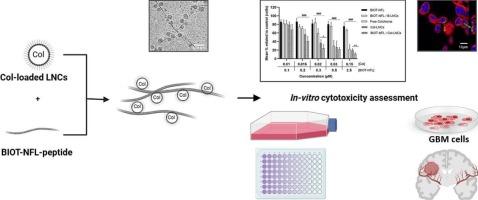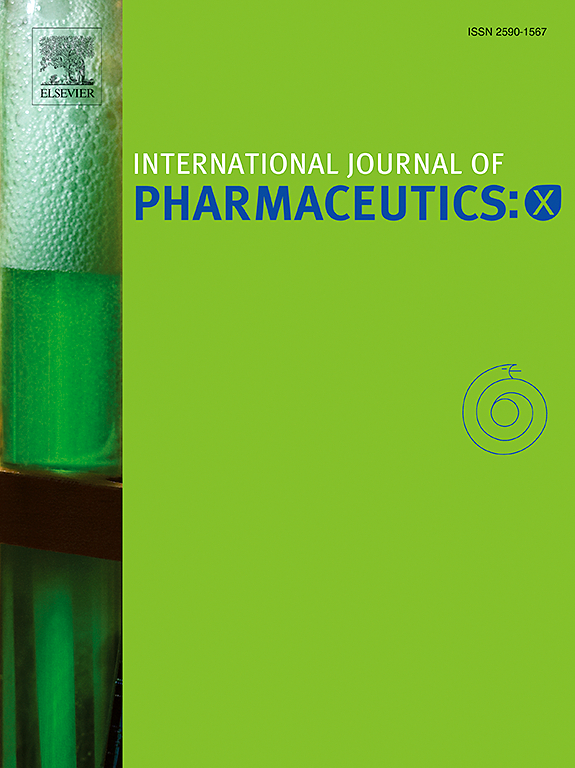结合秋水仙碱脂质纳米胶囊和biot - nfl肽靶向胶质母细胞瘤的潜在纳米递送系统的开发
IF 6.4
2区 医学
Q1 PHARMACOLOGY & PHARMACY
引用次数: 0
摘要
肽偶联纳米药物是近年来研究最多的治疗癌症的新方法之一,包括胶质母细胞瘤(GBM)。这种肿瘤,GBM,是一种难以治疗的脑肿瘤,主要是由于它的位置和靶向肿瘤细胞的复杂性。一种很有前景的GBM靶向肽(NFL-TBS.40-63)是一种细胞穿透肽(CPP),先前已证明其对GBM细胞具有选择性,并且在适当浓度下具有破坏其微管网络的能力。本研究通过将生物素化的nfl肽(BIOT-NFL)与含有秋水仙碱(Col)的脂质纳米胶囊(LNCs)偶联,开发了一种潜在的纳米递送系统。秋水仙碱是一种具有强抗癌活性的抗微管药物。首次评价了BIOT-NFL和游离秋水仙碱对GBM细胞的作用。将秋水仙碱装入脂质纳米胶囊(coll -loaded LNCs)中,对所制备的纳米胶囊进行粒径、形态、包封效率和体外释放度表征,并与biot - nfl肽偶联。有趣的是,电镜下观察到一个潜在的纳米系统,由肽纳米纤维(由BIOT-NFL形成)组成,并装饰有coll - lncs。最后,在体外评估BIOT-NFL与Col-LNCs偶联对GBM细胞的影响。这种新的纳米系统可能为GBM靶向治疗提供一个有希望的策略。本文章由计算机程序翻译,如有差异,请以英文原文为准。

Development of a potential nano-based delivery system combining Colchicine-loaded lipid nanocapsules and BIOT-NFL-peptide to target glioblastoma
Peptide conjugated-nanodrug is one of the most studied new treatment options in the field of cancer, including glioblastoma (GBM). This tumour, GBM, is a difficult to treat brain tumour mainly due to its location and the complexity of targeting tumour cells. A promising GBM-targeting peptide (NFL-TBS.40–63) is a cell penetrating peptide (CPP) that has previously demonstrated selectivity against GBM cells and also a capacity to damage their microtubule network at appropriate concentrations. Here, a potential nano-based delivery system was developed by coupling the biotinylated-NFL-peptide (BIOT-NFL) with lipid nanocapsules (LNCs) loaded with Colchicine (Col), an anti-microtubule agent with potent anticancer activity. The effect of BIOT-NFL and free Colchicine was first evaluated on GBM cells. Colchicine was then loaded in lipid nanocapsules (Col-loaded LNCs) and the obtained nanocapsules were characterized for particle size, morphology, encapsulation efficiency and in vitro release, and then coupled with the BIOT-NFL-peptide. Interestingly, a potential nanosystem composed of peptide-nanofibers (formed from BIOT-NFL) decorated with Col-LNCs was observed by electron microscopic examination. Finally, the effects of this BIOT-NFL coupled to Col-LNCs were evaluated in vitro on GBM cells. This new nanosystem may offer a promising strategy for GBM targeted therapy.
求助全文
通过发布文献求助,成功后即可免费获取论文全文。
去求助
来源期刊

International Journal of Pharmaceutics: X
Pharmacology, Toxicology and Pharmaceutics-Pharmaceutical Science
CiteScore
6.60
自引率
0.00%
发文量
32
审稿时长
24 days
期刊介绍:
International Journal of Pharmaceutics: X offers authors with high-quality research who want to publish in a gold open access journal the opportunity to make their work immediately, permanently, and freely accessible.
International Journal of Pharmaceutics: X authors will pay an article publishing charge (APC), have a choice of license options, and retain copyright. Please check the APC here. The journal is indexed in SCOPUS, PUBMED, PMC and DOAJ.
The International Journal of Pharmaceutics is the second most cited journal in the "Pharmacy & Pharmacology" category out of 358 journals, being the true home for pharmaceutical scientists concerned with the physical, chemical and biological properties of devices and delivery systems for drugs, vaccines and biologicals, including their design, manufacture and evaluation. This includes evaluation of the properties of drugs, excipients such as surfactants and polymers and novel materials. The journal has special sections on pharmaceutical nanotechnology and personalized medicines, and publishes research papers, reviews, commentaries and letters to the editor as well as special issues.
 求助内容:
求助内容: 应助结果提醒方式:
应助结果提醒方式:


